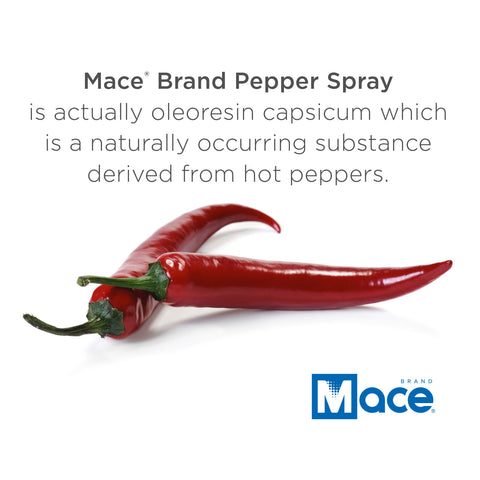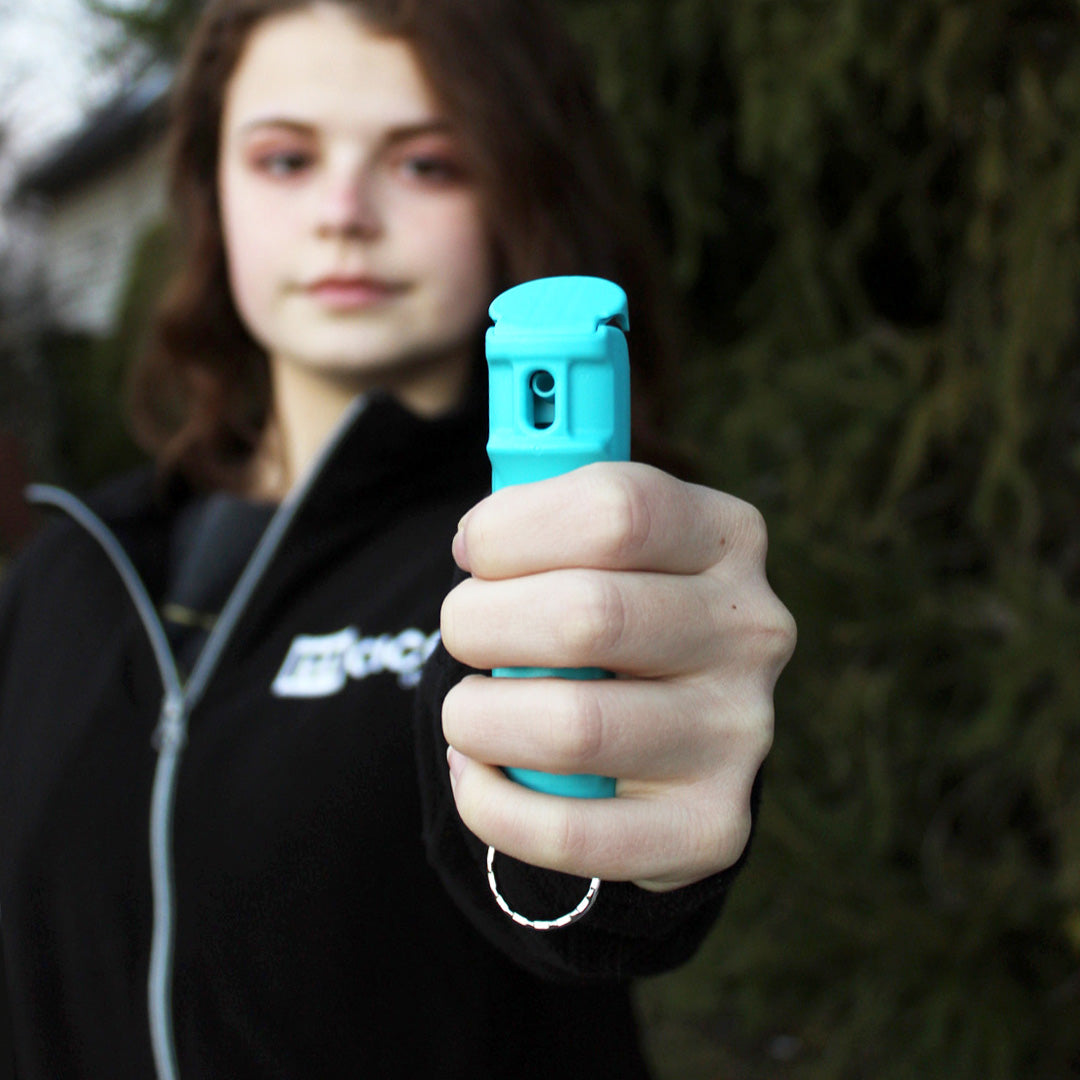Grow Your Own Peppers - Is Pepper Spray Really Made From Peppers?

Let's start with the peppers that are used to make pepper spray. Yes, pepper spray is made from peppers. At Mace® Brand, the peppers we use are hot peppers.

Let's define oleoresin capsicum by breaking down the words. Oleo means "oil," and oleoresin means "oil with resins." Capsicum is an ingredient in peppers. Oleoresin Capsicum (OC) is the oily organic resin derived from chili peppers.
FRUIT OR VEGETABLE?
What do you think? Are peppers fruits or vegetables? Could they be both?
The answer really depends on who you ask.
A botanist would call peppers a fruit because they contain tiny seeds in the middle and grow from the flower of the pepper plant.
A nutritionist or chef would call peppers a vegetable. A vegetable usually has a tougher texture and often requires cooking in dishes like stews, soups or stir-fries. Interesting.

HISTORY OF PEPPERS
Peppers have been around for about 6,000 years. Scientists disagree on whether they originated in Bolivia or Brazil. Whatever the case, birds began carrying pepper seeds across the world long ago. Birds do not have pain receptors in the mouths, so they can tolerate even the hottest peppers. Birds also cannot digest pepper seeds. That means they can deposit intact seeds just about anywhere, which assisted in the spread of pepper plants many years ago and still continues to this day.
WHAT MAKES PEPPERS HOT?
It's what's inside. The heat in peppers is called pungency, and it comes from capsaicin. The greater the concentration of capsaicin, the hotter the pepper tastes.
It's often said the seeds are the source of the heat in peppers, but while the seeds are indeed hot, they don't cause the heat. The membrane called the placenta stores the heat. The seeds are attached to the membrane, and the heat is transferred to the seeds, not stored in them.
Your mouth's pain receptors transmit the heat sensation of peppers with the help of a neurotransmitter. A runny nose and watery eyes often follow the immediate wave of fire from a hot pepper, and some people even start sweating after eating a hot pepper. Capsaicin also releases certain endorphins in the body, causing some people to feel exhilarated. A bonus, capsaicin triggers thermogenesis in many people, a fat-burning process. Some people claim eating peppers helps them lose weight.
If you've ever eaten a really hot pepper, you usually want to chug some water to douse the flames. Not a good idea. The heat-inducing compounds in peppers are fat soluble, so drinking water after you've eaten a hot pepper actually reignites the heat. Bread, chocolate, milk or other dairy products help counteract the heat. Sour cream works well too.
PEPPER MYTHS
Myth: All red peppers are hot, while all green peppers are sweets. Not true. Think about the green bell peppers you see in the produce section of most grocery stores. They can ripen into different shades of yellow, orange, or red and are still sweet. And think about Jalapenos, they are green and hot.
Another pepper myth: The number of bell pepper lobes has something to do with the gender of the pepper. Females supposedly have four lobes, are full of seeds and sweeter tasting, while males have three lobes and are less sweet. Not true. It is the flower, not the fruit, which is the sexual organ in plants. One interesting piece of sweet pepper information is that bell peppers produce flowers having both male and female parts. The number of bell pepper lobes has no bearing on the sex of the plant, it produces both.
HOW DO YOU MEASURE THE HEAT?
The spicy heat of hot peppers is measured in Scoville Heat Units. The ratings are based on the amount of sugar water needed to neutralize the spicy heat in the extracted capsaicin that is diluted in alcohol. Sounds a bit complex, but check out this chart to help clarify things.


STARTING PEPPER SEEDS
Pepper seed germination is usually much slower than other popular garden plants. Don't compare your tomato seed germination with peppers and think there is something wrong with your pepper seeds.
Tomatoes can sprout in 3-5 days in ideal conditions, while peppers might take 14 to 21 days, so you really have to be patient with peppers. The two most common problems in pepper seed germination for most of us is soil that is too cool or soil that is not moist enough. An easy way to determine soil temperature is to put a thermometer about an inch into the soil. If the soil is 80 degrees or above, you should have good success growing pepper seeds. Soil temperature below 75 degrees can delay seed germination by 3 weeks or more.
To determine your soil's moisture, touch the surface of the soil with your finger. It should be damp to slightly wet, and you should be able to feel the moisture when you rub your fingers together. If not, it's too dry.
You can maintain the soil temperature with heat mats or lights. When you water your pepper seeds, warm water from above minimizes the cooling effect on the soil. Once the seedlings have sprouted, switch to bottom watering to minimize mold and fungus issues.
TRANSPLANTING SEEDLINGS
Your new seedlings need to be conditioned or prepared for the outside garden environment. Remember, seedlings are small and tender, with soft tissues, sensitive leaves, and very small root systems. It's not a good idea to just plant them right into your garden. Instead, set the seedlings outside for short periods of time. Put them outside a little longer each time for about two weeks.
Once your seedings grow into small plants, the ideal transplanting day is a day with cloud cover with little or no breeze. Give the young pepper plants water immediately after transplanting them to help avoid shock.
The biggest concerns with transplanting your young pepper plants are the same ones you faced with the seeds: soil that is either too cold or too dry. So keep an eye on both.
Peppers like to be close, but not too close. About 18 inches of spacing between plants is a good idea. Some smaller plants can be planted a foot apart. The goal is to have the plants grow a nice leafy canopy that shades the fruit from the sun while not competing with the plant next to it.

GROWING YOUR PEPPER PLANTS
To keep your sweet peppers sweet, don't plant them next to your hot ones! Pepper plants can cross-pollinate, and you could end up with extremely hot sweet peppers. Hot peppers grow well in containers or large pots so you can grow them well away from your garden if you have the space. Separating sweet peppers by at least 50 feet from your hot peppers is a good idea.
Peppers produce best with moderate temperatures, and they can tolerate warmer days if it cools off at night.

HARVESTING YOUR PEPPERS
The key to getting big harvests from your pepper plants is the proper night time temperatures. Peppers put out the most flowers when the night temperatures range between 65 and 80 degrees Fahrenheit. Higher temperatures and high winds can cause blossom drop, which means you'll have fewer peppers grow on your plants.
Consider using mulch to maintain soil moisture levels. This could help cut down on the number of times you need to water your plants. Peppers grow best in rich, well-balanced, fertile soil.
So when is the best time to pick your peppers? You don't have to ask Peter Piper. If the pepper is easily removed from the stem, it's ready. If you have to pull or tug on the pepper, it's still too early.
As we mentioned earlier, Capsaicin, or the heat in peppers, is found on the inner ribs and seeds. If you look closely on some plants, you'll see tiny yellow dots on the ribs. If you open one of these dots, you'll feel it's effects, so be careful when you open up fresh peppers.
Now you have some great pepper growing tips and a much better understanding of peppers; they really are one of the most interesting foods on Earth.

MACE® PEPPER SPRAY
Remember, Mace® Brand pepper spray is created with OC, Oleoresin capsicum. It’s a naturally occurring substance derived from hot peppers.
Mace® Brand is committed to providing community and family safety through individual empowerment. We see personal safety devices as a way to improve quality of life, especially for those who face safety risks.
Check out our new products at www.mace.com and find out which personal safety device would be best for you: Pepper Spray vs. Pepper Gel - Which Self-Defense Product is Best for Y (mace.com)
Another story you would enjoy: How Many Colors Can a Chameleon Change? You Decide (mace.com)





Leave a comment